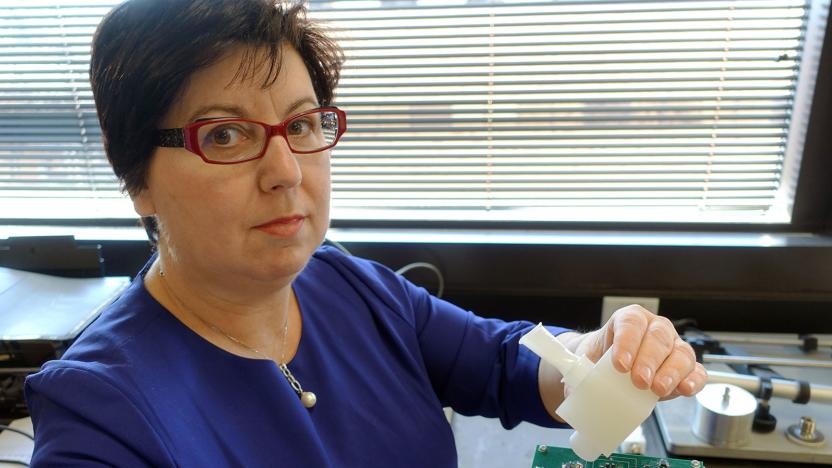flu
Latest

The most common oral decongestant in the US does not work, FDA finds
The FDA ruled that phenylephrine, a key ingredient in many over-the-counter cold medications, does not actually work to treat nasal congestion when taken orally. The agency will now need to determine if it will revoke the ingredient's oral OTC designation as “safe and effective.”

GE is working to put COVID-19 virus-detecting sensors in phones
Scientists at GE Research have been awarded a grant to develop tiny sensors that can be embedded inside phones to identify COVID-19 particles on surfaces.

Weather Channel app uses Watson to tell you when flu season is coming
Are you the sort who grows wary around other people when flu season hits? You now have another tool in your (slightly anti-social) arsenal. The latest version of the Weather Channel app for Android and iOS now includes a Flu Insights feature that uses IBM's Watson to warn you when influenza is likely to be on the warpath. The team-up wields machine learning to provide a 15-day flu forecast as well notifications that pop up at key moments, such as the start of flu season or confirmed outbreaks. Ideally, this will keep you from going to a house party full of soon-to-be-sick virus carriers.

A breath monitor could soon be used to detect the flu
What if you could pick up a device from the drug store that could tell you if you have the flu and save you a trip to the doctor? That's one possibility for a breath-analyzing gadget that University of Texas at Arlington professor Perena Gouma has developed. The device is similar to the breathalyzers law enforcement use to determine if you've had too much to drink. The difference is that it employs low-cost sensors to analyze a person's breath and isolate biomarkers that can indicate whether or not you have the flu.

Scientists watch an immune system fight the flu in real time
To date, biologists have typically had to study the progress of a virus through indirect means, such as studying the antibodies -- actually tracking the viruses themselves has been difficult. However, researchers say they've found a way to follow the progress of a virus in real time. By using multiphoton microscopy in tandem with a laser and fluorescence, the team monitored influenza virus in a mouse's trachea (where the transluency made imaging possible) through the infection and immune system response.

New flu vaccine protects test animals from multiple strains
Every now and then, it happens. You take the time to get a flu shot, but you wind up sick anyway. Bummer. That's the problem with the flu, it's not just one virus -- it's multiple variant strains. Every year, researchers have to choose one common strain on which to base the season's new vaccine. One day, that kind of guesswork could be a thing of the past: according to a new studies in Nature Medicine and Science, researchers are making significant progress on vaccines that fight multiple flu strains simultaneously.

Uber brings on-demand flu shots to Boston, NYC and DC for a day
If there's one thing on-demand car startup Uber likes more than ferrying people around, it's trying to grab people's attention with kooky promo stunts. Uber for barbecue? Uber wedding packages? Pairing riders with attractive lady drivers? Been there, done that (for better or worse). Every once in a while though, Uber cooks up something genuinely useful and today is one of those days: if you live in Boston, Washington DC or New York City, you can order an on-demand flu shot for you and up to nine of your friends until 3PM Eastern.

Pentax K-3 DSLR boasts web-based remote shooting, antialiasing control
Pentax has focused most of its recent attention on entry-level photographers, but it's showing some renewed devotion to serious shutterbugs by launching the K-3. The new 24-megapixel DSLR supports a new WiFi-equipped SDHC card, FLU, that gives owners remote control of the camera through any device with a web browser. They'll also have more control over the shots themselves: a new antialiasing toggle lets users pick between smoothness and raw detail without having to switch cameras. An updated 27-point autofocus system and 8.3 fps burst shooting are also welcome upgrades over the K-5 II. The K-3 ships this November for $1,300 body-only, or $1,700 bundled with an 18-135mm lens; a 16GB FLU card will be available at the same time for $100.

Flu-fighting teenager takes home top prize at Google Science Fair 2013
Google Science Fair 2013 came to a close yesterday, as 15 young scientists aged between 13 and 18 demonstrated their projects in front of Google's expert panel. With over a thousand submissions worldwide, only four entrants were able to take home prizes, but it was 17-year-old Eric Chen who walked away with the biggest prize. By combining computer modeling and biological studies, Chen's research focused on leads for a "new type of anti-flu medicine" to help fight the spread of the influenza virus. Australian Viney Kumar and Canadian Ann Makosinski took home awards for an early warning app for oncoming emergency vehicles and a flashlight that operates without batteries or moving parts, respectively. This year, voters got the chance to affect the outcome, awarding a new prize to Elif Bilgin, from Istanbul, who showed it was possible to create plastic from banana peel. Each winner took home a trophy built from Lego, as well as prizes from National Geographic and Scientific American. Chen, however, walked away with a $50,000 scholarship, a trip to the Galapagos Islands and his school gets both $10,000 and a Hangout with the boffins at CERN. Well deserved, we'd say.

Thermo Mirror measures body temperature, gives us something else to stare at
As good looking as we are -- and you know we are -- we sometimes get tired of staring into the mirror. Honestly, aside from reminding us of our resemblance to a young Sean Connery, the standard mirror really doesn't do much, but the Thermo Mirror is another story. The device, designed by Japanese electronics firm NEC/Avio, uses an infrared sensor to measure an onlooker's temperature from up to 30 centimeters (about 1 foot) away, without physical contact. The subject's temperature appears on the mirror's surface, and, if they have a fever, an alarm sounds. Thermo Mirror is available in two versions and costs between 98,000 and 120,000 yen (or $1,180 and $1,440). When not in use, its face displays date, time, humidity, and temperature. Now if it could just make us a martini -- shaken, not stirred, of course.

Scientists attempt to predict flu spread, give ZigBee radios to 700 high school students
This is the Crossbow TelosB wireless remote platform, and it did an important job for science in January of last year -- it monitored the close proximity interactions among 788 students and staff at one US high school to track a virtual flu. After collecting over 762,000 sneeze-worthy anecdotes among the module-toting teachers and teens, Stanford researchers ran 788,000 simulations charting the path the virus might take and methods the school might try to keep it in line. Sadly, the scientists didn't manage to come up with any easy answers, as virtual vaccination seemed to work equally well (or poorly) no matter who got the drugs, but that if only we could actually monitor individuals in real life as easily as in a study, prevention would be much easier. But who will bell the cat, when it's so much less political to ionize?

Swine Flu strikes Azeroth!
I'm sure you all will be quite happy to hear that the Swine Flu has struck Azeroth. Yes, you read that right.Out in the Borean Tundra, Unliving Swines near Warsong Hold will cast the debuff Swine Flu on you when you're fighting them. The pigs are dirty little creatures, and luckily anyone can cure the disease that has such an ability.The Swine Flu disease itself is benign, however every time you attack something it has a chance at triggering an Outbreak. An Outbreak of Swine Flu will cause a fever that inflicts 120 nature damage every 2 seconds for 8 seconds total, and reduces movement speed to 70% of normal. Like Swine Flu, Outbreak is a disease that can be cured.We should note that this isn't some joke recently put into the game. It's existed since Wrath of the Lich King released, so all the conspiracy theorists that are suggesting Blizzard manufactured the real swine flu in order to make more people stay home and play their game are clearly wrong. Clearly.Oh noes! There's a knock at the door... I think Ghostcrawler and Belfaire are here with an offer I can't refuse.

STMicro touts bird flu-detecting VereFlu "lab-on-a-chip"
We've already seen a couple of devices designed to detect and prevent bird flu (among other viruses), but STMicro says it's got 'em all beat with its new VereFlu "lab-on-a-chip," which it developed in partnership with Veredus Laboratories. That system, the company says, will let you (or the appropriate flu-detecting folks) identify and differentiate human strains of Influenza A and B, including bird flu, in a single test within two hours, as opposed to other systems that can apparently only identify one strain at time and can take days or weeks to deliver a result. The device hasn't seen any service just yet, however, although STMicro says it has received some "very promising" sales orders from hospitals and other customers, adding that it also sees potential for the device to be used to screen travelers at airports and border checkpoints.[Via PC World]








